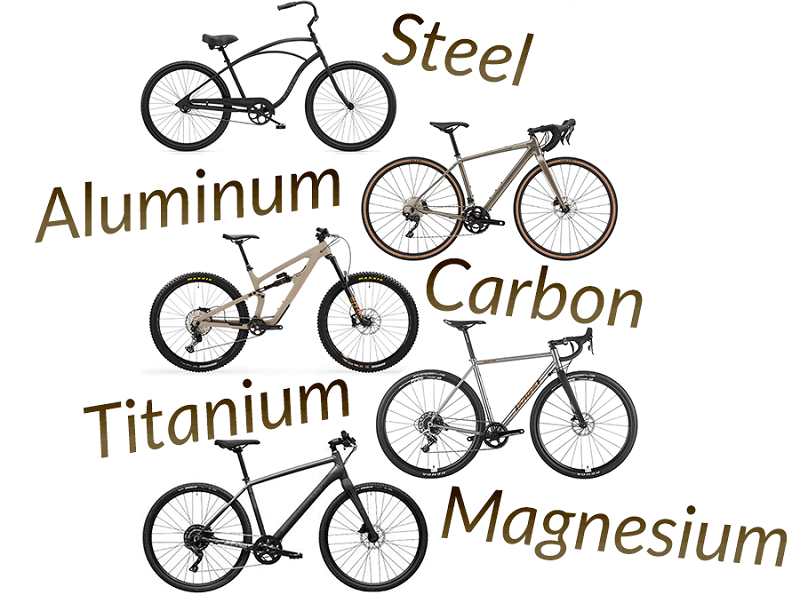Parts
Types Of Bicycle Frame Materials Explained
When it comes to selecting the ideal bicycle frame material, you’ll be confronted with a plethora of options, each with its unique set of characteristics, advantages, and disadvantages. In this guide, HookBike will explore the various types of bicycle frame materials available, giving you an in-depth understanding of what makes each one distinct. Armed with this knowledge, you can make an informed decision about which bicycle frame material is the best fit for your cycling needs.
Types Of Bicycle Frame Materials Explained
Bicycle frames can be made from various materials, each with its own set of characteristics and advantages. The choice of frame material can greatly affect a bike’s weight, strength, ride quality, and cost. Here are some of the most common types of bicycle frame materials explained:
Steel Frames
Steel frames have been a staple in the cycling world for decades. They are renowned for their durability and strength. Steel frames provide a smooth, comfortable ride, effectively absorbing road vibrations. However, they can be heavier compared to some other materials.
Advantages of Steel Frames
- Durability: Steel frames are incredibly robust and can last for many years with proper maintenance.
- Comfort: They offer a comfortable ride by dampening road vibrations.
- Affordability: Steel frames are often more budget-friendly compared to some other materials.
Disadvantages of Steel Frames
- Weight: They tend to be heavier, which can affect acceleration and climbing performance.
- Corrosion: Steel frames are prone to rust if not properly cared for.

Aluminum Frames
Aluminum frames have gained popularity for their lightweight nature. They provide a responsive and efficient ride, making them an excellent choice for riders who prioritize speed.
Advantages of Aluminum Frames
- Lightweight: Aluminum frames are significantly lighter than steel, aiding in quicker acceleration and improved climbing performance.
- Stiffness: They offer excellent power transfer, making them suitable for racing and high-performance cycling.
- Affordability: Aluminum frames are often more affordable than carbon fiber frames.
Disadvantages of Aluminum Frames
- Harsh Ride: The stiffness of aluminum frames can result in a harsher ride, especially on rough roads.
- Fatigue: They may cause more rider fatigue on long-distance rides compared to other materials.
Carbon Fiber Frames
Carbon fiber frames are known for their exceptional strength-to-weight ratio. They are the go-to choice for many professional cyclists and enthusiasts due to their unparalleled performance capabilities.
Advantages of Carbon Fiber Frames
- Ultralight: Carbon fiber frames are incredibly lightweight, enhancing speed and agility.
- Stiffness: They offer outstanding stiffness for efficient power transfer.
- Aerodynamics: Carbon frames are often designed with aerodynamics in mind, improving overall speed.
Disadvantages of Carbon Fiber Frames
- Cost: Carbon frames tend to be more expensive than steel or aluminum.
- Durability: While robust, they are susceptible to damage in the event of a crash.
Titanium Frames
Titanium frames are the epitome of durability and corrosion resistance. These frames offer a unique combination of strength and comfort, making them a favorite among long-distance cyclists.
Advantages of Titanium Frames
- Durability: Titanium frames are exceptionally durable and resistant to corrosion.
- Comfort: They provide a smooth and comfortable ride, ideal for long journeys.
- Lightweight: While not as light as carbon fiber, they are lighter than steel.
Disadvantages of Titanium Frames
- Cost: Titanium frames can be quite expensive due to the material’s scarcity and challenging manufacturing process.
Bamboo
Bamboo frames are an environmentally friendly option. They offer a comfortable and shock-absorbing ride. These frames are often handcrafted and can be customized, but they are relatively rare.
Composite Materials
Some frames are constructed from a combination of materials, such as carbon fiber and aluminum or steel and carbon. These combinations aim to offer the best of both worlds, like strength, weight savings, and affordability.
Magnesium
Magnesium frames were briefly popular but have largely fallen out of favor due to their corrosion susceptibility and other issues.
See more: bike frame measurement chart

The choice of frame material depends on your riding style, budget, and personal preferences. Road cyclists may favor lightweight carbon fiber frames, while mountain bikers might opt for a durable aluminum frame.
Touring enthusiasts often prefer steel or titanium for their durability, and bamboo frames offer a unique, eco-friendly alternative. It’s essential to consider the trade-offs in terms of weight, cost, and durability when selecting a bicycle frame material. Additionally, frame geometry and design play a significant role in a bike’s overall ride quality, so it’s wise to consider those aspects alongside the frame material.
Which type of Bicycle Frame should I choose?
The choice of a bicycle frame depends on several factors, including your riding style, budget, and personal preferences. Here are some considerations to help you decide which type of bicycle frame is best for you:
Riding Style
- Road Cycling: If you primarily ride on smooth roads and want speed and efficiency, a lightweight carbon fiber or high-quality aluminum frame is a good choice.
- Mountain Biking: For off-road adventures and rugged terrains, consider an aluminum or carbon fiber mountain bike frame with suitable suspension features.
- Touring and Commuting: Durable steel or titanium frames can be excellent options for carrying loads and providing a comfortable ride on long journeys.

Budget
Different frame materials come at varying price points. Carbon fiber frames are generally the most expensive, while steel and aluminum frames are more budget-friendly. Custom or high-end titanium frames can be quite costly.
Frame Weight
If you prioritize a lightweight bike, carbon fiber frames are the lightest. Aluminum frames are also relatively lightweight. Steel and titanium frames are heavier but offer other advantages, such as durability and comfort.
Ride Quality
Consider the type of ride quality you desire. Carbon fiber frames can be very stiff, which is good for speed but may feel harsh on rough roads. Steel and titanium frames offer more compliance and a smoother ride.
Durability
If you want a frame that can withstand heavy use and abuse, steel and titanium are known for their durability. Aluminum is also strong, but it may be more susceptible to damage in certain situations.

Customization
If you want a bike that’s tailored to your exact specifications, custom frames made from steel, titanium, or even bamboo offer the most flexibility.
Aesthetics
The look of the frame is a personal preference. Some people appreciate the classic appearance of a steel frame, while others prefer the modern and sleek look of carbon fiber.
Maintenance
Different materials require varying levels of maintenance. For example, steel frames can rust if not properly cared for, while carbon fiber frames need to be inspected for cracks or damage.
Environmental Considerations
If you’re environmentally conscious, bamboo frames are a sustainable option. Additionally, buying a high-quality, durable frame that will last a long time can be an eco-friendly choice.
Test Rides
Whenever possible, test ride bikes with different frame materials to get a feel for their characteristics. The way a frame handles can be just as important as its material.
See more: what are bike frame sizes?

There is no one-size-fits-all answer to which frame you should choose. It’s essential to prioritize your needs and preferences and, if possible, consult with a knowledgeable bike shop or professional to ensure that you select a frame that suits your riding style and goals.
Conclusion
The choice of bicycle frame material is a critical decision that impacts your riding experience. Each material has its own set of advantages and disadvantages, and the right choice for you depends on your cycling preferences and budget. Steel frames are renowned for their durability, aluminum for their lightweight and responsiveness, carbon fiber for their unmatched performance, and titanium for their durability and comfort.
When selecting a bicycle frame material, consider factors like your riding style, terrain, and budget. Whether you’re a professional racer, a casual rider, or a long-distance enthusiast, understanding the characteristics of each frame material will help you make an informed decision. Ultimately, the best frame material is the one that aligns with your cycling goals and enhances your overall riding experience.
Make sure to check out our in-depth reviews and recommendations for specific frame models within each material category. This will further assist you in making a well-informed decision, and you’ll be well on your way to finding the perfect bicycle frame material that suits your needs.
The key to an exceptional cycling experience begins with selecting the right frame material that complements your style and ambitions. Happy cycling!

